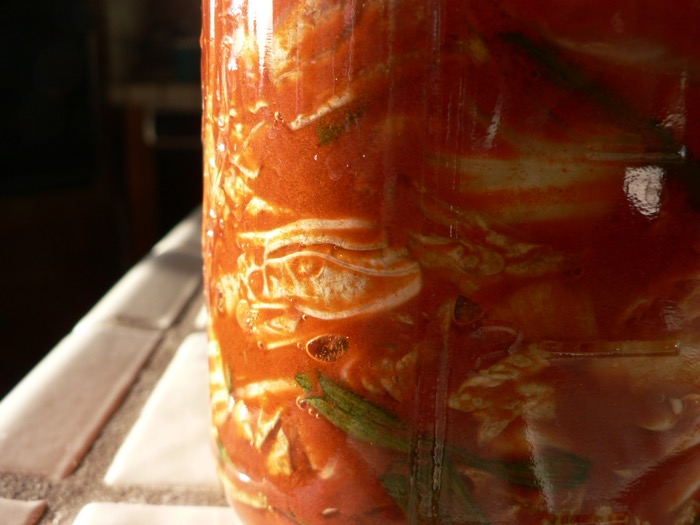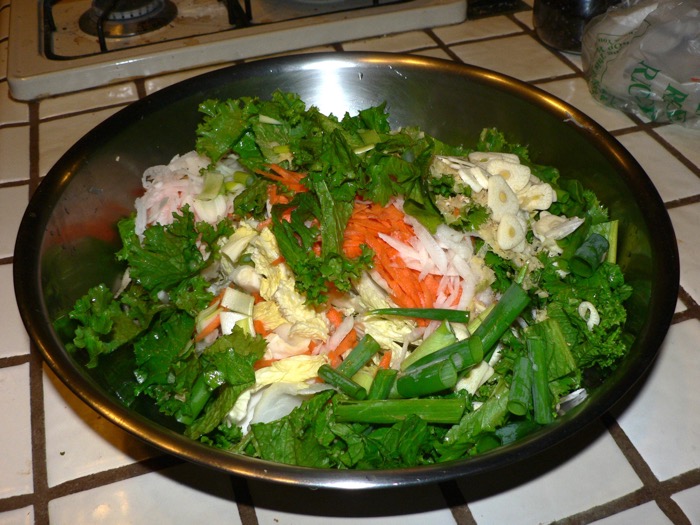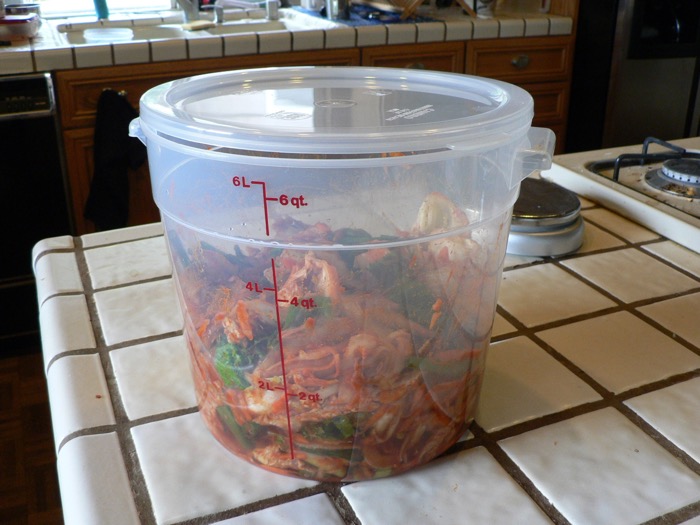On the Making of Kimchi
15 Feb 2011
For a number of years now I’ve been making big batches of kimchi in the wintertime. I make it when the big heads of chinese cabbage start to show up in the farmer’s markets, sometime just before Christmas, and it lasts me in jars through to the spring. Like jam and pickles and applesauce, kimchi is one of the seasonal foods I look forward to making and putting away every year, and one that I give away to friends.
Kimchi is a traditional Korean pickle. Although you can make kimchi from a variety of vegetables, kimchi is most commonly associated with cabbage.
Stories abound of how the Koreans bury their kimchi pots in the ground in the fall and dig them up again in the spring, when the kimchi has well and truly rotted. I think westerners tell these stories because kimchi can have a very strong taste and smell, and that can be scary to a western palate used to blander food. Describing kimchi as a sort of zombie food that must be disinterred to be eaten seems to explain its more exotic and terrifying qualities.
Kimchi is not rotten. Like saukraut, kosher half-sour dill pickles, kefir, and sourdough starter, true kimchi is a fermented food. Although kimchi has a lot of chile pepper in it, its strong taste and smell comes mostly from natural yeasts and bacterias that develop over time in the mixture of vegetables in the pot. The kimchi pot does not need to be buried. Koreans traditionally buried the pot for the same reason root cellars exist; its easier to moderate the temperature of food underground if you don’t have artificial heating and cooling. No one does that any more.
This is how I make kimchi, based on a bunch of recipes I found on the internet years ago and adaptations I have made over the years. It requires about 45 minutes of actual work and 5-10 days of very casual tending. This isn’t an exact recipe, because I don’t precisely measure anything. My kimchi is different every year because of the amounts of things I have on hand and also because fermentation is not an exact science. There’s no way to duplicate it every time, to make it perfectly safe and uniform. That’s why it’s so special.
You Will Need
To make kimchi you will need:
1 3-4 lb head of chinese (napa) cabbage, chopped into 1-inch pieces
Salt
Water
1 small bunch of mustard greens, chopped
1 bunch scallions, chopped into 1-2 inch lengths
1 Daikon radish, grated, about a cup
1 carrot, grated, about a cup
1 1-inch section of ginger, grated
1 head of garlic (yes, I said a head. 4-5 big cloves, 7-8 small cloves), peeled and sliced thin
A little sugar
A little salt
1/3 cup of Korean powdered chile pepper
Some kimchi from a previous batch
A little water
The first time I tried to make kimchi I used plain western cabbage and cayenne pepper. Both of these were bad ideas. Western cabbage has entirely the wrong texture. Kimchi is not korean spicy coleslaw. Seek out real chinese cabbage, otherwise known as napa cabbage.
Make sure you also get actual korean powdered chile pepper. I tried using cayenne pepper and was surprised that my kimchi was too hot to eat. Kimchi is mildly spicy-hot, but most of the strength and the depth of the flavor comes from the fermentation, not from the peppers. I also tried other chiles and found that nothing tasted right until I actually went to a Korean market and got Korean chile powder. There’s something about the terroir. Fortunately, a huge jar of Korean chile pepper only costs a couple bucks.
You can get mustard greens from large fancy grocery stores these days, or from any Asian grocery. Don’t use the stems. You can leave these out if you can’t find them, but I find they really add an interesting taste.
Step 1. Salt
This step is optional. Salting the cabbage helps it release some moisture. You’ll end up with a limper less crunchy kimchi. I think it helps the kimchi ferment faster. If you’d prefer a more vegetable-tasting, crunchier kimchi, omit this step.
Layer the cabbage with salt in a big bowl or a plastic tub and cover with water. The water should taste slightly salty, like seawater. Add more salt if necessary Let sit for 4-5 hours, or overnight. Drain and rinse.
Step 2. Mix

Add the cabbage and all the remaining ingredients to the largest bowl you own and mix them all together. I like to mix the vegetables first with my hands, and then add the chile powder and a little water with a big spoon.

If you don’t have kimchi left over from a previous batch, that’s OK. You add a few spoonfuls to this batch as a “starter” to get this batch going faster with the right bacteria for the fermentation.
Step 3. Ferment

After mixing everything together, I put the kimchi into a tub and leave it out on the back porch to ferment. I used to use a stoneware pickle crock or glass half-gallon mason jars for this, but recently I discovered these food-safe plastic restaurant tubs and they’re a lot easier to keep clean and haul around. Don’t seal the top; you need it open a crack to let the good critters in there to do their work. Open in and stir it once a day or so.
How long you leave the kimchi out to ferment depends on how strong a taste you like and how nervous you are about letting food sit around unrefrigerated. A day or two in cool weather and you’ll get a very mild flavor, a crunchier kimchi, and you’ll still be able to taste the vegetables. A week in the sun and the kimchi will develop a spicy, sour, intense flavor, and look more pickled.
Why out on the porch? As the kimchi develops the smell will get stronger and more powerful, and an open jar of it can spread all over your kitchen like chemical warfare. I happen to like the smell, but others in your household may not agree.
Needless to say that if your kimchi turns a funny color or grows mold then your fermentation has failed and you should throw it out. I have never lost a batch but I can see it happening.
Don’t be afraid to experiment. Most of the years I made kimchi I only left it out for a few days. This last year I forgot about it entirely and rediscovered it out on the porch after ten days. I opened the jar and leaned over for a look and all the skin on my skull melted right off, like the Nazis at the end of Raiders of the Lost Ark. That was some really great stuff.
Posted on 15 Feb 2011 • in blog •